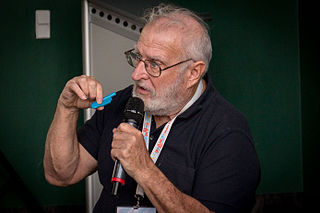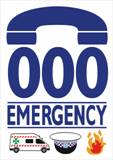Related Research Articles
Phreaking is a slang term coined to describe the activity of a culture of people who study, experiment with, or explore telecommunication systems, such as equipment and systems connected to public telephone networks. The term phreak is a sensational spelling of the word freak with the ph- from phone, and may also refer to the use of various audio frequencies to manipulate a phone system. Phreak, phreaker, or phone phreak are names used for and by individuals who participate in phreaking.

9-1-1, usually written 911, is an emergency telephone number for Argentina, Brazil, Canada, Jordan, Mexico, Palau, Panama, Philippines, the United States, Uruguay, as well as the North American Numbering Plan (NANP), one of eight N11 codes. Like other emergency numbers around the world, this number is intended for use in emergency circumstances only. Using it for any other purpose is a crime in most jurisdictions.

An emergency telephone number is a number that allows a caller to contact local emergency services for assistance. The emergency number differs from country to country; it is typically a three-digit number so that it can be easily remembered and dialed quickly. Some countries have a different emergency number for each of the different emergency services; these often differ only by the last digit.
Caller identification is a telephone service, available in analog and digital telephone systems, including voice over IP (VoIP), that transmits a caller's telephone number to the called party's telephone equipment when the call is being set up. The caller ID service may include the transmission of a name associated with the calling telephone number, in a service called Calling Name Presentation (CNAM). The service was first defined in 1993 in International Telecommunication Union—Telecommunication Standardization Sector (ITU-T) Recommendation Q.731.3.

A blue box is an electronic device that produces tones used to generate the in-band signaling tones formerly used within the North American long-distance telephone network to send line status and called number information over voice circuits. This allowed the user, referred to as a "phreaker", to surreptitiously place long-distance calls that would be billed to another number or dismissed entirely as an incomplete call. A number of similar "color boxes" were also created to control other aspects of the phone network.

John Thomas Draper, also known as Captain Crunch, Crunch, or Crunchman, is an American computer programmer and former phone phreak. He is a widely known figure within the computer programming world and the hacker and security community, and generally lives a nomadic lifestyle.

An answering machine, answerphone, or message machine, also known as telephone messaging machine in the UK and some Commonwealth countries, ansaphone or ansafone, or telephone answering device (TAD), is used for answering telephone calls and recording callers' messages. When a telephone rings a set number of times predetermined by the call's recipient the answering machine will activate and play either a generic announcement or a customized greeting created by the recipient. Unlike voicemail, an answering machine is placed at the user's premises alongside—or incorporated within—the user's landline telephone, and unlike operator messaging, the caller does not talk to a human. As landlines become less important due to the shift to cell phone technology, and as unified communications evolve, the installed base of TADs is shrinking.
A voicemail system is a computer-based system that allows users and subscribers to exchange personal voice messages; to select and deliver voice information; and to process transactions relating to individuals, organizations, products, and services, using an ordinary phone. The term is also used more broadly to denote any system of conveying a stored telecommunications voice messages, including using an answering machine. Most cell phone services offer voicemail as a basic feature; many corporate private branch exchanges include versatile internal voice-messaging services, and *98 vertical service code subscription is available to most individual and small business landline subscribers.

A telephone call is a connection over a telephone network between the called party and the calling party.
Call waiting is a telephone service where a subscriber can accept a second incoming telephone call by placing an in-progress call on hold—and may also switch between calls. With some providers it can be combined with additional features such as conferencing, call forwarding, and caller ID. Call waiting is intended to alleviate the need to have more than one telephone line or number for voice communications.
The Tube Bar prank calls are a series of prank calls made in the mid-1970s to the Tube Bar in Jersey City, in which Jim Davidson and John Elmo would ask "Red," the proprietor of the bar, if they could speak to various non-existent customers. The gag names given by the pranksters were puns and homophones for often offensive phrases. Recordings of the calls were circulated widely on duplicated cassette tapes and may have been the inspiration for a long running gag in The Simpsons.
111 is the emergency telephone number in New Zealand. It was first implemented in Masterton and Carterton on 29 September 1958, and was progressively rolled out nationwide with the last exchanges converting in 1988.

In the early days of telephony, companies used manual telephone switchboards, and switchboard operators connected calls by inserting a pair of phone plugs into the appropriate jacks. They were gradually phased out and replaced by automated systems, first those allowing direct dialing within a local area, then for long-distance and international direct dialing.
In telephony, an automated attendant allows callers to be automatically transferred to an extension without the intervention of an operator/receptionist. Many AAs will also offer a simple menu system. An auto attendant may also allow a caller to reach a live operator by dialing a number, usually "0". Typically the auto attendant is included in a business's phone system such as a PBX, but some services allow businesses to use an AA without such a system. Modern AA services can route calls to mobile phones, VoIP virtual phones, other AAs/IVRs, or other locations using traditional land-line phones or voice message machines.
In telecommunications, a long-distance call (U.S.) or trunk call is a telephone call made to a location outside a defined local calling area. Long-distance calls are typically charged a higher billing rate than local calls. The term is not necessarily synonymous with placing calls to another telephone area code.

000 Emergency, also known as Triple Zero or Triple 0, and sometimes stylised Triple Zero (000), is the primary national emergency telephone number in Australia. The Emergency Call Service is operated by Telstra, and overseen by the Australian Communications and Media Authority (ACMA), and is intended only for use in life-threatening or time-critical emergencies.

AT&T Merlin is a corporate telephone system by American Telephone and Telegraph (AT&T) that was introduced in late 1983, when it was branded American Bell Merlin. After the breakup of AT&T in 1984, it was rebranded and later also supplied by Lucent and Avaya.

A telephone number is a sequence of digits assigned to a landline telephone subscriber station connected to a telephone line or to a wireless electronic telephony device, such as a radio telephone or a mobile telephone, or to other devices for data transmission via the public switched telephone network (PSTN) or other public and private networks.
A prank call is a telephone call intended by the caller as a practical joke played on the person answering. It is often a type of nuisance call. It can be illegal under certain circumstances.

Zzzzzz, later just Z, was a dial-a-joke service active in the 1970s and early 1980s. Started by Bob Bilkiss (1949–1989) of West Los Angeles in 1970, the line operated from the 213 area code and was named so to appear last in the Los Angeles telephone directory. Emerging from a wave of dial-a-joke numbers in Los Angeles in the turn of the 1970s, Zzzzzz enjoyed a high level of popularity in its day. For several years, it was the busiest residential telephone number in the United States, if not the world.
References
- ↑ Wolf, Gar. "The World According to Woz". Wired . Retrieved April 7, 2010.
- ↑ Steve Wozniak & Gina Smith, IWoz: Computer Geek to Cult Icon, page 127, W.W. Norton & Company, 2007
- ↑ Stix, Harriet (May 14, 1986). "A UC Berkeley Degree Is Now the Apple of Steve Wozniak's Eye". Los Angeles Times . Retrieved January 5, 2015.
- ↑ Lapsley, Phil (2013). Exploding the Phone: The Untold Story of the Teenagers and Outlaws who Hacked Ma Bell. Grove Atlantic. p. 181. ISBN 9780802193759 – via Google Books.
- ↑ Townsend, Sylvia (April 22, 1979). "The Joke's on Them". The Pittsburgh Press. E. W. Scripps Company. p. 4. Retrieved November 16, 2021– via Newspapers.com.
- ↑ Joseph Boskin, The Humor Prism in 20th-century America, page 120, Wayne State University Press, 1997
- ↑ Anthony Hiss, "Next!" (The Talk of the Town), The New Yorker, page 33, April 14, 1974
- ↑ Dial-a-Joke ad, Daily News, May 22, 1974, 117
- ↑ Joke, The Herald Statesman, September 26, 1982, page 7
- ↑ Eddie Knight, Dial-a-Joke humor strikes phone-in public’s funny bone, The Miami Herald, July 20, 1980, page 33
- ↑ "Dialing Service". Variety . June 29, 1960. p. 1. Retrieved February 13, 2021– via Archive.org.